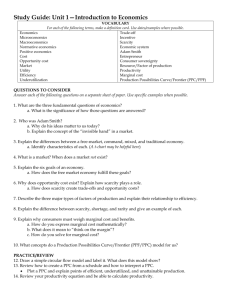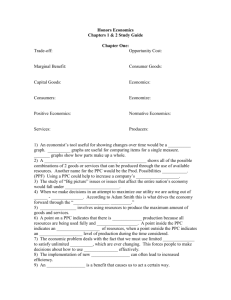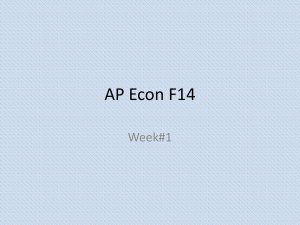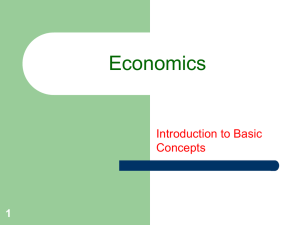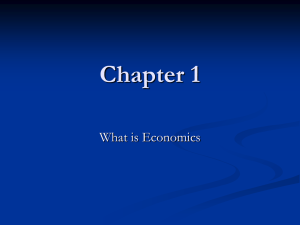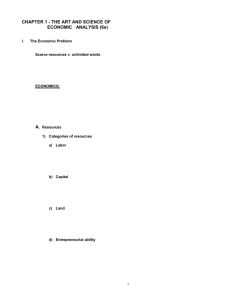Chapter 1 – Limits, Alternatives and Choices
advertisement
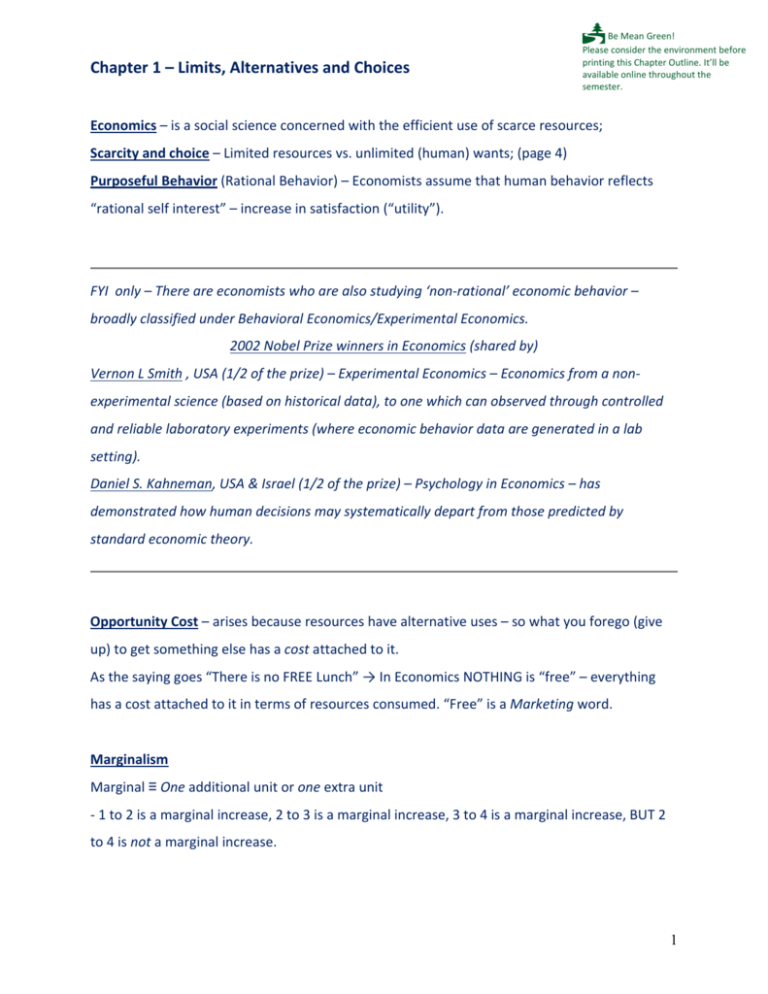
3 Be Mean Green! Chapter 1 – Limits, Alternatives and Choices Please consider the environment before printing this Chapter Outline. It’ll be available online throughout the semester. Economics – is a social science concerned with the efficient use of scarce resources; Scarcity and choice – Limited resources vs. unlimited (human) wants; (page 4) Purposeful Behavior (Rational Behavior) – Economists assume that human behavior reflects “rational self interest” – increase in satisfaction (“utility”). FYI only – There are economists who are also studying ‘non‐rational’ economic behavior – broadly classified under Behavioral Economics/Experimental Economics. 2002 Nobel Prize winners in Economics (shared by) Vernon L Smith , USA (1/2 of the prize) – Experimental Economics – Economics from a non‐ experimental science (based on historical data), to one which can observed through controlled and reliable laboratory experiments (where economic behavior data are generated in a lab setting). Daniel S. Kahneman, USA & Israel (1/2 of the prize) – Psychology in Economics – has demonstrated how human decisions may systematically depart from those predicted by standard economic theory. Opportunity Cost – arises because resources have alternative uses – so what you forego (give up) to get something else has a cost attached to it. As the saying goes “There is no FREE Lunch” → In Economics NOTHING is “free” – everything has a cost attached to it in terms of resources consumed. “Free” is a Marketing word. Marginalism Marginal ≡ One additional unit or one extra unit ‐ 1 to 2 is a marginal increase, 2 to 3 is a marginal increase, 3 to 4 is a marginal increase, BUT 2 to 4 is not a marginal increase. 1 Ex: (An approximate example in iPods) iPod: 1GB ‐ $49; 2GB ‐ $69; [4GB ‐ $148; 80GB ‐ $248] (marginal cost of adding more memory is not very high, i.e., doubling memory space from 1GB to 2GB, or 2GB to 4GB does not double the cost.) As rational people, if Marginal Benefit (MB) is more than Marginal Cost (MC), we would choose to do that activity – which means if the benefits outweigh the costs, the activity is worthwhile. So: If MB > MC Do the activity If, MB < MC Do not do the activity Marginal Analysis And, in Economics, the optimal solution is where, MB = MC Why study Economics? - essential for being a well informed citizen / voter - helps improve analytical skills (economics stresses precise, systematic analysis) - vital to business decision making - helps consumers (& workers) make better buying (or employment) decisions - helps making better financial decisions Theories, Principles and Models The scientific approach or scientific method in Economics: 1. Observe real‐world behavior and outcomes (historical data) 2. Based on these formulate a hypothesis 3. Test the hypotheses 4. Accept or reject the hypotheses, or modify to better fit/explain the events/data 5. Continue hypothesis testing till sufficiently large number of observation database is created 6. Based on adequate favorable results, a hypotheses evolves into a theory 7. A well tested and widely accepted theory becomes a Law or Principle (ex: Law of Demand, or Principles of Economics) Models – simplification of reality but not over‐simplification ‘Assume’ – making assumptions to simplify reality (purposeful simplifications) Ceteris paribus – Other things equal or holding everything else constant – used to simplify complex reality 2 Economic Principles are Generalizations relating to economic behavior, i.e., how a typical or average consumer would behave, or a group of typical consumers would behave. There can always be exceptions, or variations from that behavior – but we are not concerned with the exceptions here. Microeconomics – deals with households/firms as specific economic agents (individual decision making units) Economics Macroeconomics – deals with economy as a whole, aggregate Individual’s Economic Problem: LIMITED INCOME VS. UNLIMITED WANTS Ex: Possible budget choices of a person earning $1,000 (say, per month) Option Monthly Rent Food Other Expenses TOTAL Possible A $400 $250 $350 $1,000 Yes B $600 $200 $200 $1,000 Yes C $700 $150 $150 $1,000 Yes D $1,000 $100 $100 $1,200 No Limited Income – Most of us have a finite (fixed) income per month (from our wages, salaries, profits, etc.) [Look at the GLOBAL SNAPSHOT 1.1, on page 9, which shows Average Income in a few select countries – (total income/population), or per capita income.] Unlimited wants – Most people have unlimited wants, from necessities to luxuries. [Example: Photo Op – Necessities versus Luxuries, on page 10] A Budget Constraint (Line) 3 It is a schedule or curve that shows various combinations of two products that a consumer can purchase with a specific money income. Ex: Mary has a weekly income of $100. She can spend this on Chinese food at $20 per meal, or basketball games at $10 per game ticket. - She spends all her income on Chinese meals → 5 meals - She spends all her income on Basketball game tickets → 10 tickets Basketball tickets 10 Budget Constraint (Line) New BC after price falls Unattainable Attainable 5 10 Chinese meals Change of prices/ change of income If price of Chinese meals drops to $10 per meal → 10 meals now (no change in price of Basketball tickets) → Price drop of Chinese meals makes you feel a bit ‘Richer’ i.e., your money goes a bit further. (New Budget Constraint after price falls – broken red line.) Price Fall ⇒ makes you feel a bit “RICHER” Price Rise ⇒ makes you feel a bit “POORER” The Budget Constraint (Line) illustrates the idea of trade‐offs arising from limited (fixed) income. The fact that to have a certain amount of Chinese meals, you have to give up a certain amount of Basketball game tickets. The idea that you can’t have it all. 4 The straight‐line Budget Constraint, with its constant slope, indicates constant opportunity costs. (So, a limited income forces people to make choices – what to have, and what to forego.) Society’s Economic Problem: Like an individual, society also has to make choices under conditions of scarcity, and faces a similar economic problem. (page 12) Scarce Resources: (also called Factors of Production) Economists classify economic resources into four broad categories: [Take a look at some examples, on page13, Photo Op ‐ Economic Resources] Land – includes all natural resources e.g., land, forests, water resources, mineral and oil deposits, etc. Labor – physical and mental talents of individuals used in producing goods and services e.g., services provided by a retail clerk, a professional football player, nuclear physicist, doctor, etc. Capital – capital goods used to manufacture goods and services, e.g., factories, storage, transportation & distribution facilities, tools and machinery, other equipment, etc. “Capital” in Economics DOES NOT refer to money. Money is simply a means of purchasing capital goods. Entrepreneurship – The entrepreneur takes the initiative of combining land, labor and capital to produce goods and services. He is the innovator, risk bearer and makes the strategic business decisions to set the course of the business. [Entrepreneurial ability – Donald Trump in the last picture, under Photo Op, page 13.] Production Possibilities Model (Curve – PPC, or Frontier – PPF) (page 14) Assumptions: - Full employment – of all available resources - Fixed resources – the factors of production are fixed at this point of time - Fixed technology – newer technology is not available at this point of time - Two goods – The economy is producing only TWO goods – ‘guns’ (capital goods) and ‘butter’ (consumer goods) 5 Production Possibilities Table [Refer to Figure 1.2, on page 14.] A table which lists different combinations of two products that can be made with a given amount of resources, given the above assumptions. Guns PPC/ PPF Unattainable Attainable Butter Anywhere on PPC – Attainable and efficient (Productive efficiency); Anywhere inside PPC – Attainable but inefficient; Anywhere outside PPC – Unattainable (currently) Optimal Allocation (page 16) Guns Allocative efficiency PPC Butter MB & MC MC Optimal is where MB = MC MB Butter 6 The Law of Increasing Opportunity Costs As the production of a good increases, the opportunity cost of producing an additional unit rises. So the PPC is bowed out from the origin, or concave to the origin. [Look at APPLYING THE ANALYSIS, on page 17 – The Economics of War, to get a feel of Optimal Allocation between civilian and defense goods.] Unemployment, Growth, and the Future A Growing Economy – Relaxing some of the initial assumptions – What is the impact on the PPC? For example, unemployment (and a lengthy recession) does what to the PPC, or access to newer sources of resources (how does it impact the PPC), or acquiring newer technology …? [APPLYING THE ANALYSIS, on page 20, impact of technology, or biotechnology – on the PPC.] Guns Earlier PPC Current PPC Economic Growth (Shifting of the PPC to the right) Butter Can PPC shift to the left? Why/ when? 7 Graphs – visual depictions y y x x - Negative slope - Positive slope - If x increases, y decreases (or - If x increases, y increases (or - - Inverse or indirect relationship Direct relationship between x &y between x & y the opposite) the opposite) For all the following graphs: Vertical axis = y; Horizontal axis = x Positive & Increasing slope Positive & Decreasing slope (becoming steeper) (becoming flatter) 8 For all the following graphs: Vertical axis = y; Horizontal axis = x Negative & Increasing slope Negative & Decreasing slope (becoming flatter) (becoming steeper) Maximum y-axis Minimum x axis 9 For all the following graphs: Vertical axis = y; Horizontal axis = x $ Slope = ∞ (infinity) $ Slope = 0 Quantity-axis 10
